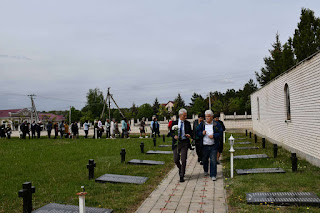  Events Archive Events Archive
Actions dedicated to the Day of Commemoration of the Victims of the Famine organized in 1946-1947
Avdarma, April 20, 2024
On April 20, 2024, the Museum of Victims of Deportations and Political Repressions, NMHM in cooperation with the Association of Former Deportees and Political Prisoners of Moldova and in partnership with the Avdarma History Museum, ATU Gagauzia, the Institute of History, MSU, the State University of Comrat, the Regional Directorate Education UTA Găgăuzia, and the ProMemoria Institute Public Association organized the scientific-practical conference for schoolteachers from UTA Gagauzia with the generic "Teaching of the optional subject for the 9th, 12th grades «The totalitarian-communist regime: repression and resistance movement»". The event was attended by university professors, scientific researchers, schoolteachers, museographers.
The conference held in the context of the Day of Commemoration of the Famine Victims organized in 1946-1947 started with the laying of flowers at the Memorial of Famine Victims in the village of Avdarma, ATU Gagauzia.
In the section of communications and debates, the curriculum of the optional subject "The totalitarian-communist regime: repression and the resistance movement" and the theoretical-methodological materials recommended for the organization and teaching of the course in ATU Gagauzia were presented. In particular, the participants discussed the issues of the history of the organized famine of 1946-1947 and the impact of this phenomenon on the localities in the south of the Moldovan SSR.
During the event, the curriculum of the optional subject "The totalitarian-communist regime: repression and resistance movement" (2024), the collection "Can Acisi / Боль души" (2022) with oral history works were distributed to school teachers as a donation of students from the village of Avdarma on the subject of the famine of 1946-1947 in the village of Avdarma, the collection "Soviet state terror and resistance to the totalitarian regime. Хроника очень выбор 1917-1991 годов" (2017), the volume of documents "Голод в Мольдове", coord. Anatol Țaranu (1993), and the collection of documents "Православие в Молдове", vol. I (1940-1953), vol. II (1953-1960), vol. III (1961-1975), vol. IV (1976 -1991), coord. Valeriu Pasat.
At the end of the event, the official transmission of the Partnership Agreement between the National History Museum of Moldova and the Avdarma History Museum took place. The parties were represented by the Head of the Museum of Victims of Deportations and Political Repressions, branch of the National History Museum of Moldova, dr. Ludmila Cojocari and the Director of the Avdarma History Museum, Mrs. Elena Caramit.
|




















































































